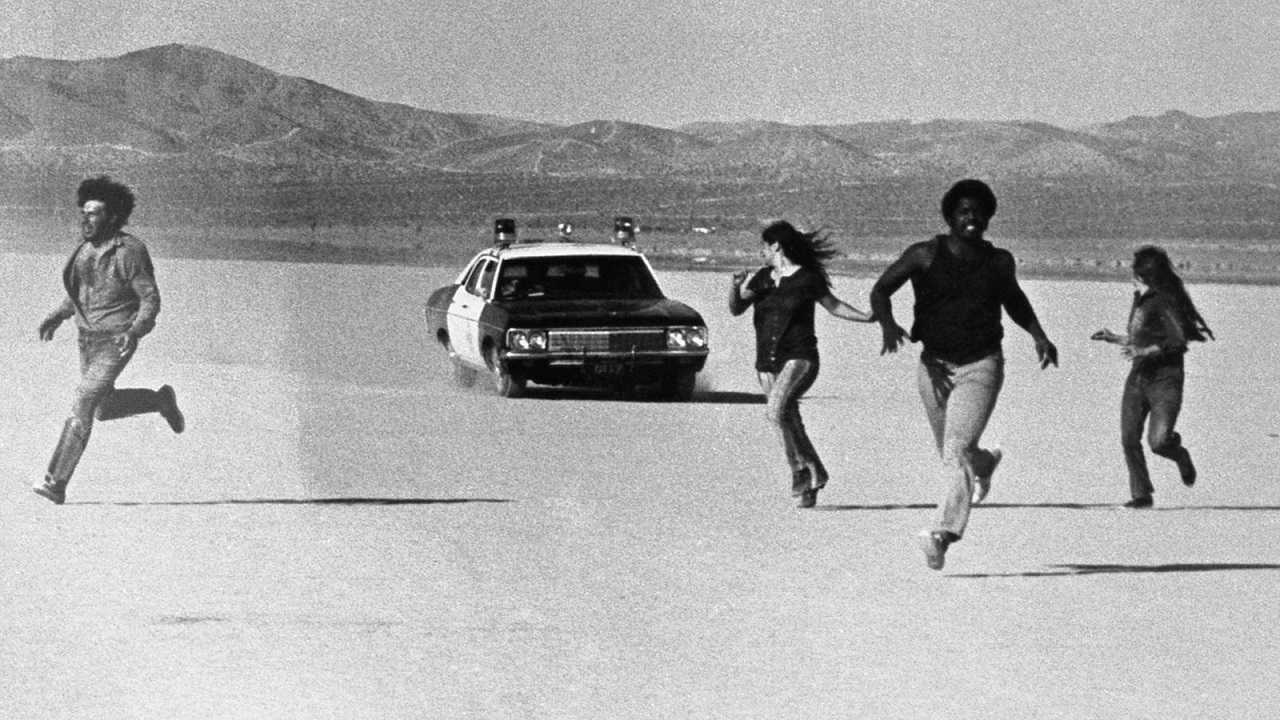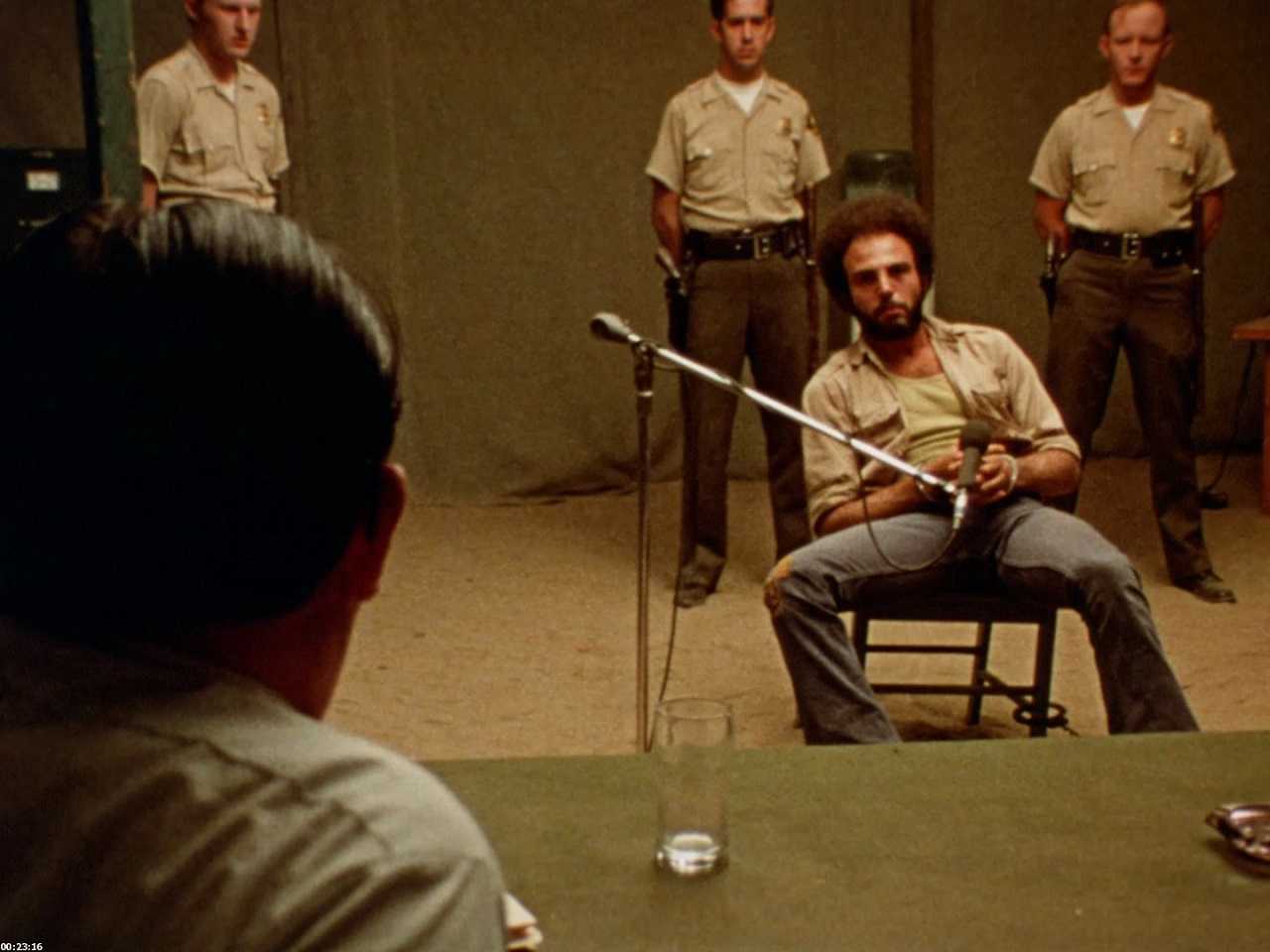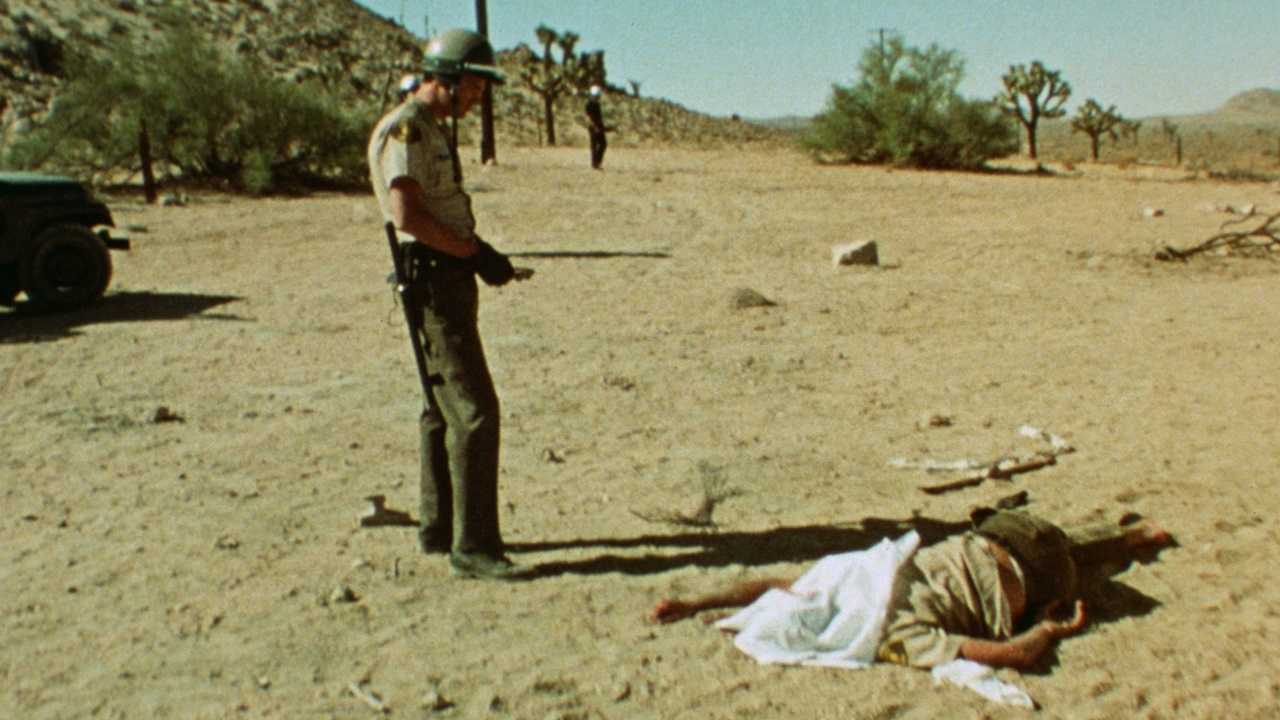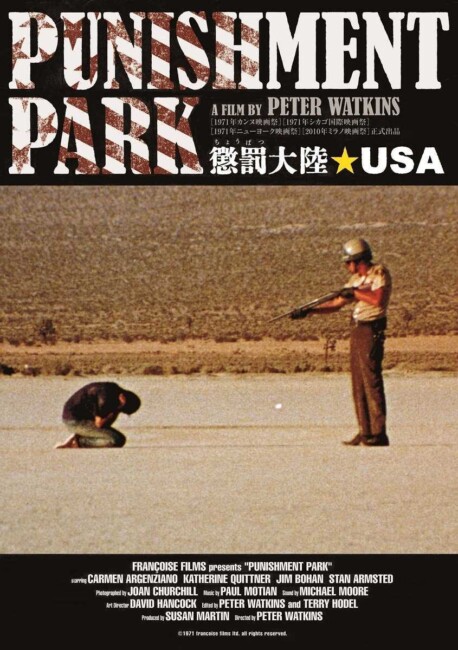UK. 1971.
Crew
Director/Screenplay – Peter Watkins, Producer – Susan Martin, Photography – Joan Churchill & Peter Smokler, Music – Paul Motian, Art Direction – David Hancock. Production Company – Francoise.
Cast
Carmen Argenziano (Jay Kaufman), Stan Armstead (Charles Robbins), Katherine Quittner (Nancy Smith), Scott Turner (James Kohler), Mary Ellen Kleinhall (Allison Mitchner), Jim Bohan (Captain Edwards), Mark Keats (Chairman William Hoeger), Gladys Golden (Mary Jurgens), Frederick Franklyn (James Daly), Sanford Golden (Senator Harris), Lee Marks (Agent Robert Donovan)
Plot
It is the near future. The US government has imposed the McCarran Act, which suspends many civil liberties and Fifth Amendment rights. A group of protestors have been arrested on various charges ranging from draft dodging, being Communists, and engaging in racial protest or speech and songs designed to incite revolt against civil order. They face the choice of spending several years in jail. Either that or winning their freedom in Punishment Park, which requires that they survive a harsh cross-country journey of 53 miles through the Mojave Desert to reach a flag without being recaptured. Hunting them are several members of the local sheriff’s department and National Guard. As they set out on their run, the pursuit is followed by English and German camera crews who are filming specials for tv. As the crews watch, they realise that the pursuing law enforcement are trigger-happy and only too willing to shoot the unarmed protestors.
Punishment Park was the fifth film from British director Peter Watkins. Watkins had had earlier success with Culloden (1964) for the BBC, where he took the novel approach of shooting a recreation of the famous 18th Century battle in a documentary-like style, and The War Game (1965), which depicted a fictional outbreak of nuclear war in England in a similar style. Indeed, Peter Watkins is the father of the mockumentary – several decades before the term was coined. These films gained Watkins a considerable reputation, particularly after the BBC refused to screen The War Game for whom it has originally been commissioned.
Following this, Peter Watkins went on to make a trio of highly political films all using science-fictional devices with Privilege (1967) set in a near-future England where the government manipulate the popularity of a rock singer; The Peace Game/The Gladiators (1969) set in a future where instead of conducting war governments settle their differences by pitting soldiers against one another in an arena; and Punishment Park. Subsequent to these, Watkins abandoned genre material and moved to Sweden and later France, which he found a more welcoming home after the negative reception his films had had in England. Based there, he made the likes of Edvard Munch (1974), Evening Land (1977), The Journey (1987), The Freethinker (1994) and La Commune (2000).
Punishment Park is an extraordinary work. As you sit watching the opening scenes where the narrator is describing a fictional near-future scenario, what is being portrayed proves so alarmingly a prediction of how the future turned out that they could be describing America anytime in the 00s. The film talks about the prisoners being held and sentenced under the McCarran Act (an actual piece of US legislation, now repealed) that allows for the suspension of civil liberties, habeas corpus and Fifth Amendment rights; nowadays it is called the Patriot Act and the setting could just as easily be Guantanamo Bay instead of the middle of the Mojave Desert.

In fact, there are frequent times you have to shake yourself and realise that the film was made in 1971, not the mid-00s, so much so has its vision of a police state invisibly crept into modern America. About the only difference is that the prisoners are Vietnam War protestors rather than Islamic militants. And so far, the US government has yet to come up with a system whereby Guantanamo prisoners could earn their freedom by making a fifty mile run through the desert while being shot at by law enforcement officials – Abu Ghraib did come close to the general idea, although in the reality there the prison authorities did not even bother with the illusion of allowing prisoners to make a bid for their freedom.
It is amazing how much Punishment Park has had an influence on modern films. The basic scenario – of people being allowed to fight to the death for their freedom while usually watched by tv cameras – has been adopted by numerous other dystopian/near future films since such as The Prize of Peril (1982), Turkey Shoot (1983), The Running Man (1987), Battle Royale (2000), Series 7: The Contenders (2001), The Condemned (2007), Death Race (2008), Gamer (2009), The Hunger Games (2012) and Turkey Shoot (2014).
It may well be that Peter Watkins drew the basic premise from the classic The Most Dangerous Game (1932) about a man and woman stranded on a desert island where they are hunted by a bored Russian aristocrat who gives them the opportunity to win their lives by fleeing through the jungle and fighting with their bare hands. Some inspiration may also have been taken from the satirical Italian science-fiction film The Tenth Victim (1965) where contestants can win prizes by killing one another on camera.

It is interesting to compare Punishment Park to these modern equivalents. If it were made today, Punishment Park would almost certainly be pitched as an action film and the emphasis placed on the survival of the various prisoners in the desert with numerous scenes pumped up to show them having to fight for their lives against their hunters. You can argue that the action movie never existed as an entity back in 1971 and so Punishment Park did not have this to draw on. Certainly, Peter Watkins does not seem interested in traditional story arcs of heroism, struggle and triumph. A classical action film almost always follows a clearcut hero/heroine but here, for example, the characters only seem an aggregate collection of talking heads, rarely as individuals.
What Peter Watkins is interested in in Punishment Park however is the ideological conflict. As much time is given to the scenes where each of the principal accused are put on trial as the scenes with the prisoners fleeing through the desert. Watkins is largely interested in the scenes where each prisoner gets to say their piece, angrily remonstrating against the system over everything from the Vietnam War and the draft, bourgeoisie values and racial disparities. The cast give extremely angry and convincing performances and each piece of declamation comes with remarkably incisive effect. Watkins makes no pretence of offering an unbiased account, his point-of-view is with the protestors and their anger the entire way. The judging tribunal of establishment figures are all portrayed with such a contempt of counter-cultural values and lofty hypocrisy that they become despicably loathsome.
If other films of the era like Woodstock (1970) and Zabriskie Point (1971) emotionally swept one up in the counter-culture values of the Love Generation, then Punishment Park can be considered the intellectual voice of the revolution. Indeed, Punishment Park could be a veritable manifesto for other revolutionary groups of the era such as Black Panthers, Weather Underground and the Symbionese Liberation Army. In subsequent films about the era made years later – see the likes of 1969 (1988) or Across the Universe (2007) – the revolutionary speech of the day has been watered down until it is little more than a cliche. However, Punishment Park comes from the day where such was fresh and full of anger and emotion that had not been diluted by being placed in historic quote marks.

Peter Watkins largely improvised the film with his cast. He apparently started out with a more structured screenplay but stripped this back and allowed the cast to improvise their own dialogue and speeches. In using a cinema verite style, this allows Watkins a far more ‘real’ look than the other more dramatically composed films of the era. The actors have a far greater naturalism and the camera seems merely to be observing what is going on rather than directing them to express for us.
The only name among the cast that was ever heard from again (Watkins always prefers using non-professional actors) is Carmen Argenziano who has gone onto a lengthy career in film and television. Perhaps one of the most disturbing things about the film is the end voice-over claim that various of the actors in the film were subsequently convicted for the same sorts of crimes that there characters were – Stan Armstead was charged with attempting to plant a bomb, while one of the other actors was sentenced to jail for three years for assault.
All of this makes for an incredibly charged and angry film. Indeed, Punishment Park comes with such a stark sense of revolutionary anger that it was pulled from distribution in England within only a week of its opening, was refused screening in the US where even today television channels will not screen the film by mutual agreement. To be still regarded as seditious after nearly forty years is an incredibly far-reaching power for a film. And for what it says to still be as applicable today as it was back in the 1970s is even more of a testament.
Trailer here


